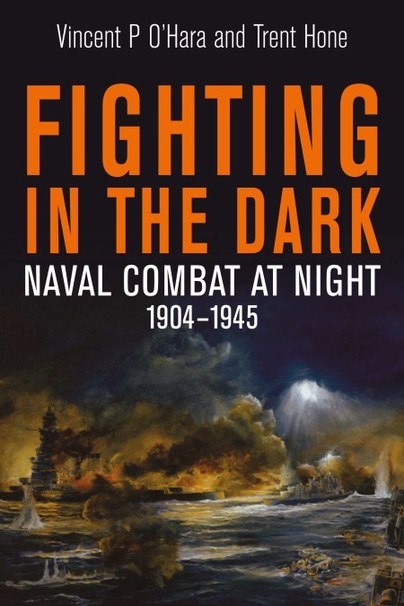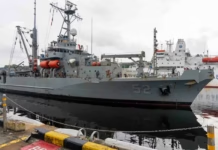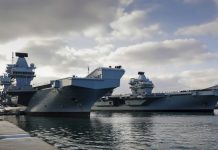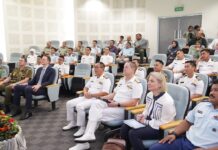
Fighting in the Dark; Naval Combat at Night 1904 – 1945. Edited by Vincent P O’Hara and Trent Home. Seaforth Publishing. Barnsley, Yorkshire, 2023.
Reviewed by Tim Coyle
Naval combat at night conjures images of confused, high intensity movement dramatically illuminated by searchlights, star shell and explosions as torpedoes impact hulls.
Fighting in the Dark introduces the reader to the subject matter through a review of maritime night encounters from ancient times and progresses through the transition from sail to steam and the technological developments in the second half of the 19th century.
These developments – searchlights, torpedoes and their launch platforms and rapid-firing guns – made adoption of night fighting doctrine a necessity. However, this only came through hard-learned experience.
The book portrays night actions and documents tactical developments in seven Chapters:
Chapter 1: Stumbling in the Dark; The Russo-Japanese War 1904-1905;
Chapter 2: Tactics of Frustration: The German Navy and Night Combat 1914-1916;
Chapter 3: The British and Night Fighting At and Over The Sea;
Chapter 4: Forced to Fight: Italy, 1940-1943;
Chapter 5: How Can They Be So Good?; Japan 1922-1942;
Chapter 6: Mastering the Masters; The US Navy 1942-1944;
Chapter 7: Controlling the Chops (English Channel): Destroyer Night Action and the Battle of Ile De Batz, October 1943-June 1944.
The overall theme of the book is the narrative of the progression towards innovative doctrine and tactics for light forces to fight at night. The introduction of torpedoes and searchlights, rapid-firing guns and small, fast and manoeuvrable torpedo boats/torpedo boat destroyers, allowed for asymmetric attacks on stronger forces. However, there was a gap between the theoretical potential of this warfare discipline and the reality in the maelstrom of battle. The defeats suffered at Port Arthur and Tsushima led the Russian navy to adopt a strategy based on mine and torpedo warfare which proved effective against German Baltic ports in 1914. Japanese night attacks returned lacklustre results but stimulated the development of a night light forces harassing capability.
Rapid decision-making and well-trained crews were critical, as was formation tactics. The RN developed and exercised night fighting doctrine and tactics up to capital ship level in the interwar period. The Italian Regia Marina lost a heavy cruiser division due to a lack of heavy ship night fighting preparedness as the service had only addressed small craft harassing attacks.
Of particular interest is how the US Navy learnt from the severe losses at the battles of the Java Sea, Tassafaronga, Kula Gulf and Kolombangara in 1942. The Japanese navy had refined night tactics since the early 1920s and, together with its formidable ‘long lance’ torpedoes, stunned the USN; however, radar and the development of the Combat Information Center figured prominently in bringing American night fighting capability to its zenith in 1945.
As with all Seaforth Publications titles, Fighting in the Dark is a high-quality production featuring clear maps of the night encounters, supported by relevant photographs. The text is absorbing and detailed, written by respected historians. The book is dedicated to the late Rear Admiral James Goldrick RAN (Rtd), who wrote Chapter Three.
Fighting in the Dark featuring a brilliantly told narrative of the night actions and how night fighting doctrine evolved. While the study ends in 1945, before the modern era of satellites, missiles, combat data systems and the emerging unmanned platforms, the fundamental need for innovative thinking, rapid decision-making and highly trained personnel is just as relevant today as it was during the naval night fighting era.



